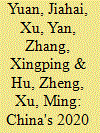| Srl | Item |
| 1 |
ID:
127299


|
|
|
|
|
| Publication |
2014.
|
| Summary/Abstract |
China has proposed its 2020 clean energy target together with the climate change target of reducing CO2 intensity of the economy by 40-45% below the 2005 level. This article investigates the feasibility of these targets by testing their consistency under possible economic development scenarios. We analyse these targets from two perspectives: consistency with the overall economic growth and consistency with the international society's expectation on China's greenhouse gas (GHG) abatement responsibilities. The main findings are: under the recently announced 2020 target of gross domestic product (GDP) that is double the 2010 level, the adoption of a 15% clean energy target could result in excessive primary energy demand; and then with 40-45% GDP CO2 intensity reduction, CO2 emissions in 2020 could substantially exceed the International Energy Agency (IEA) 450 ppm scenario for China. Thus we propose a 17% clean energy target that can reconcile the domestic plan with international expectation. Our article also outlines the pathways to realise clean energy development into 2020 and proposes policy recommendations.
|
|
|
|
|
|
|
|
|
|
|
|
|
|
|
|
| 2 |
ID:
150016


|
|
|
|
|
| Summary/Abstract |
Shortage of feedstock has hindered the development of China's biomass power generation because it is highly difficult to collect straw in China. We pioneered a new feedstock supply model in which the formal official organization of villagers' committees is introduced. Different from the previous feedstock supply patterns, the immaterial utility of relative stakeholders and the impact of villagers' committees on farmers' behavior are considered in this paper. To compare this pattern's performance with that of the conventional ones, this paper developed a multi-agent model specifically for China's situation. We applied the model to simulate the operation of a biomass supply chain. The results show that the proposed feedstock supply pattern can significantly increase the profits of biomass plants, biomass supply amounts, and farmers' participation, and in contrast with the broker pattern, it can lower feedstock prices through disintermediation. Sensitivity analyses show that preferential feed-in tariffs are still necessary for biomass power and that the new pattern can ease the government's subsidy burdens. Additionally, farmers' opportunity costs for supplying biomass, their perceptions of immaterial utility and the cooperative's financial resource schemes of the public welfare fund all have differing impacts on the achievement of the new pattern.
|
|
|
|
|
|
|
|
|
|
|
|
|
|
|
|